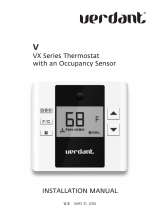3
Table of Contents
Thermostat Installation ............................................................................... 7
Installing the Wireless Control Card ............................................................8
Mounting the thermostat to the wall .........................................................9
Thermostat Configuration ......................................................................... 10
Setting the thermostat clock .......................................................................11
Entering the room number ......................................................................... 12
Configuring the Equipment Settings - Compressor Type ........................... 13
Configuring the Equipment Settings - Electric Heat ..................................14
Configuring the Equipment Settings - Reversing Valve .............................15
Configuring the Energy Saving Settings ....................................................16
Testing the thermostat ............................................................................... 17
Thermostat Settings....................................................................................18
Accessing the Thermostat Settings ............................................................18
FAN ENERGY SAVINGS ................................................................................19
1
ST
STAGE DIFFERENTIAL - HEAT ................................................................. 20
2
ND
STAGE DIFFERENTIAL - HEAT ................................................................ 21
1ST STAGE DIFFERENTIAL - COOL................................................................22
INCIDENTAL OCCUPANCY THRESHOLD ......................................................23
FORCED 2ND STAGE HEATING ................................................................... 25
NIGHT OCCUPANCY START ........................................................................ 26
NIGHT OCCUPANCY END ............................................................................27
TEMPERATURE RECOVERY TIME ............................................................... 28
RECOVERY TEMPERATURE - HEAT ............................................................ 29
TEMPERATURE SETBACK DELAY - HEAT .................................................... 30
MINIMUM SETBACK TEMPERATURE ......................................................... 31
TEMPERATURE SETBACK DELAY - COOL .....................................................32
MAXIMUM SETBACK TEMPERATURE ......................................................... 33
RECOVERY TEMPERATURE - COOL ............................................................ 34
MINIMUM SETPOINT ................................................................................. 35
MAXIMUM SETPOINT ................................................................................. 36
AUTO CHANGEOVER SETPOINT OFFSET ....................................................37
SETBACK SETPOINTS / AUTO-RESTORE .................................................... 38




















